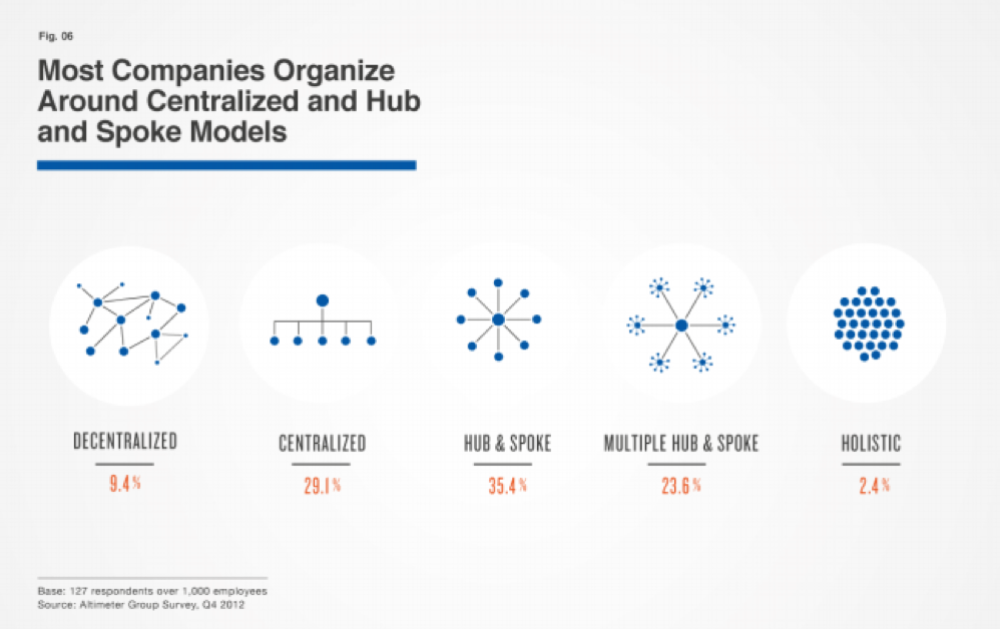A seven-part introduction to Instagram: Part Two - Resource Allocation
Before developing an Instagram account or any social media account, it is imperative that you review your available resources to ensure the longevity and success of an account.
Creating a robust model enables clarity in regards to roles and responsibilities. This installment of our seven part Instagram guide details popular organisation models, as according to Altimeter Group’s 2012 study. Note that Resource Allocation is relevant and applicable to all your social media accounts.

Altimeter Group
Social media internal organization models
Organic or decentralized:
Anyone is free to participate and start a social channel. Responsibility is spread across various departments in the organization.
Advantages: Looks authentic and therefore trusted as multiple conversations appear closer to products and customers.
Disadvantages: Inconsistent experience for customers, one side of the company has no idea what the other side is doing. It has the potential to become a nightmare for IT/data management and marketing with difficulties in tracking and ownership of channels.
Centralised:
One department (usually Corporate Communications) controls all efforts top-down.
Advantages: Consistent customer experience, coordinated resources and rapid response.
Disadvantages: May appear inauthentic as they are not close to the content.
Coordinated or hub-and-spoke:
A cross-functional team sits in centralized position and helps various nodes such as business units and product teams. Red Cross utilizes this well to keep various chapters organized, especially during life-threatening crises.
Advantages: The central group is aware of what each node is doing and provides a holistic experience to customers with centralized resources.
Disadvantages: Must be very collaborative. Requires clear internal management, and cross-departmental buy-in.
Multi hub-and-spoke:
Often seen in large multinational companies where ‘companies within companies’ act nearly autonomously from each other under a common brand. Companies with multiple products like HP and IBM may naturally gravitate toward this direction.
Advantages: Business units are given individual freedom to deploy as they see fit, yet a common experience is shared amongst all units.
Disadvantages: Requires constant communication from all teams to be coordinated which can result in excessive internal noise. More breakdown in communications tend to occur.
Holistic:
Everyone is in customer service and support and any employee who wants to be social is enabled. Dell computers and Zappos brand utilize this model.
Advantages: Tapping into your entire workforce (Best Buy’s Twelpforce is an example) to support and help customers.
Disadvantages: Require executives that are ready to let go; a lot of trust in employees and executives that walk the talk (they must do it themselves).
Roles and responsibilities
Content collection:
Collect relevant images, video, external content, competition ideas, etc. for possible use on social media. Round table meeting to discuss upcoming, relevant content to be distributed.
Responsible: Social media champion and department representatives.
Content creation:
Refine content collected, making sure it is consistent with brand proposition and real, genuine tone. Populate into content calendar.
Responsible: Social media champion and department representatives.
Content posting:
Post and schedule content to the relevant channels as per the content calendar.
Responsible: Social media champion.
Monitoring and reporting:
Monitor all channels and profiles and ensure correct parties are notified in the event of customer queries or potential crisis. Ensure social media listening is set up to inform future content and use in reporting as necessary. Measure and track KPIs on an ongoing basis. Create analytics report to circulate to key stakeholders.
Responsible: Social media champion.
Community response and customer service:
Respond to members in a prompt and appropriate manner.
Responsible: Social media champion and customer services (liaise with relevant parties).
Resourcing requirements, risk management and escalation process
Who will be responsible for scheduling social media posts?
Whilst social media revolves around the concepts of immediacy, and timely content, it is common practice for organisations to schedule content such as a review of the Federal Budget and what it will mean for their stakeholders (the actual content cannot be written in advance but the topic can be scheduled in). Therefore, it is important to have an individual (or team) tasked with scheduling content in advance, whether this be monthly or quarterly. To ensure checks are in place, the person or team charged with scheduling content should be separate from those responsible for publishing content.
How do you currently deal with feedback and PR?
Is feedback categorized into themes and topics and then assigned to a specific department, or will it be answered by the reader? Think about what the different processes will look like for your stakeholders, be careful not to seem as if you are handballing them around the office. Set time frames for how quickly you will respond to feedback of different priorities and stick to this. If you have an upcoming press release consider what reactions may be and get the team ready to respond with a briefing. Define an escalation process and make sure that everyone involved with your social media is familiar with it.
How will you mitigate risk?
Be proactive in posting any expected and unexpected faults, issues, shutdowns or technical difficulties to minimize the risk of an overload of users experiencing and posting about the same issue. Always include an expected completion/repair date and time for when operations will return to normal.

